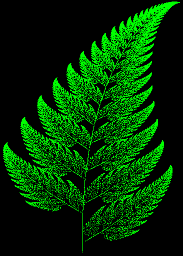![[C# Helper]](../banner260x75.png)
|
|
 |
![[Beginning Database Design Solutions, Second Edition]](db2_79x100.png)

Title: Draw a Barnsley fern fractal in C#
This example draws a Barnsley fern fractal. For information about this kind of fractal, see Barnsley's Fern by Eric W. Weisstein from MathWorld, a Wolfram Web Resource. The program starts from a random point. At each step, it randomly picks a function (with non-uniform probability) and applies the function to the point to find the next point. It then plots that point. Each function has the form:
X(n+1) = A * X(n) + B * Y(n) + C The following code initializes the probability and function parameters.
private float[] Prob = { 0.01f, 0.85f, 0.08f, 0.06f }; private float[, ,] Func = { { {0, 0}, {0, 0.16f}, }, { {0.85f, 0.04f}, {-0.04f, 0.85f}, }, { {0.2f, -0.26f}, {0.23f, 0.22f}, }, { {-0.15f, 0.28f}, {0.26f, 0.24f}, }, }; private float[,] Plus = { {0, 0}, {0, 1.6f}, {0, 1.6f}, {0, 0.44f}, }; The Prob array gives the probabilities of picking each of the different functions. The Func array contains the values A, B, D, and E. The Plus array holds the values C and F. The following MakeFern method draws the fractal into a Bitmap and displays it.
private void MakeFern() { int wid = picCanvas.ClientSize.Width; int hgt = picCanvas.ClientSize.Height; Bitmap bm = new Bitmap(wid, hgt); using (Graphics gr = Graphics.FromImage(bm)) { gr.Clear(Color.Black); Random rnd = new Random(); int func_num = 0, ix, iy; float x = 1, y = 1, x1, y1; for (int i = 1; i <= 100000; i++) { double num = rnd.NextDouble(); for (int j = 0; j <= 3; j++) { num = num - Prob[j]; if (num <= 0) { func_num = j; break; } } x1 = x * Func[func_num, 0, 0] + y * Func[func_num, 0, 1] + Plus[func_num, 0]; y1 = x * Func[func_num, 1, 0] + y * Func[func_num, 1, 1] + Plus[func_num, 1]; x = x1; y = y1; const float w_xmin = -4; const float w_xmax = 4; const float w_ymin = -0.1f; const float w_ymax = 10.1f; const float w_wid = w_xmax - w_xmin; const float w_hgt = w_ymax - w_ymin; ix = (int)Math.Round((x - w_xmin) / w_wid * picCanvas.ClientSize.Width); iy = (int)Math.Round( (picCanvas.ClientSize.Height - 1) - (y - w_ymin) / w_hgt * hgt); if ((ix >= 0) && (iy >= 0) && (ix < wid) && (iy < hgt)) { bm.SetPixel(ix, iy, Color.Lime); } } } // Display the result. picCanvas.BackgroundImage = bm; } The MakeFern method starts at point (1, 1) and repeatedly applies randomly selected functions, plotting each point on the Bitmap. Download the example to experiment with it and to see additional details. |
![[Beginning Software Engineering, Second Edition]](book_sw_eng2_79x100.png)
![[Essential Algorithms, Second Edition]](book_algs2e_79x100.png)
![[The Modern C# Challenge]](book_csharp_challenge_80x100.jpg)
![[WPF 3d, Three-Dimensional Graphics with WPF and C#]](book_wpf3d_80x100.png)
![[The C# Helper Top 100]](book_top100_80x100.png)
![[Interview Puzzles Dissected]](book_interview_puzzles_80x100.png)
![[C# 24-Hour Trainer]](book_csharp24hr_2e_79x100.jpg)
![[C# 5.0 Programmer's Reference]](book_csharp_prog_ref_80x100.png)
![[MCSD Certification Toolkit (Exam 70-483): Programming in C#]](book_c_cert_80x100.jpg)
